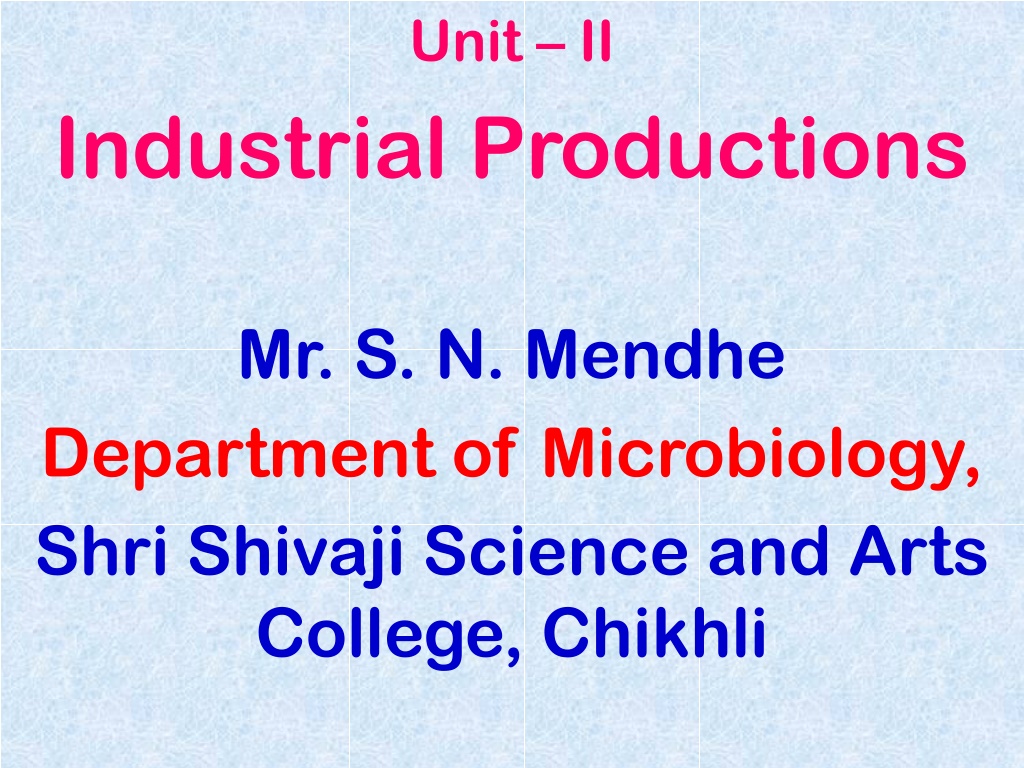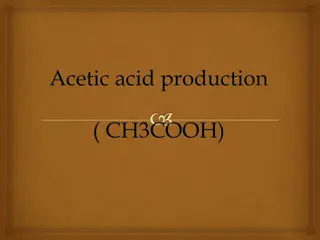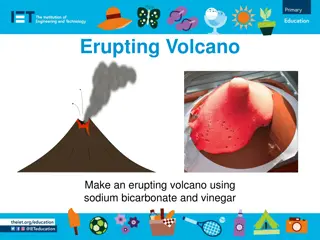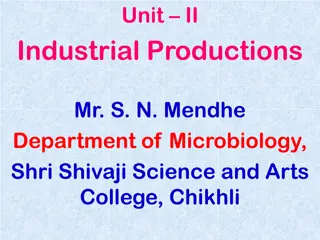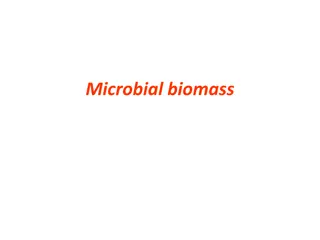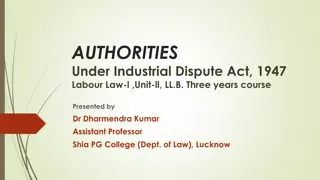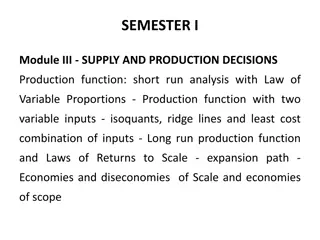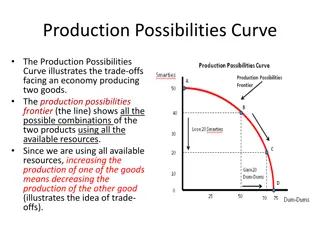Understanding the Industrial Production of Vinegar
Vinegar fermentation, with its rich history and diverse classification based on raw materials, involves two essential fermentations - alcoholic fermentation and acetous fermentation. Various microorganisms, particularly Acetobacter species, play a crucial role in vinegar production. Different methods such as the Orleans Process and Submerged Fermentation Process are utilized for the production of vinegar.
Uploaded on Jul 19, 2024 | 0 Views
Download Presentation

Please find below an Image/Link to download the presentation.
The content on the website is provided AS IS for your information and personal use only. It may not be sold, licensed, or shared on other websites without obtaining consent from the author. Download presentation by click this link. If you encounter any issues during the download, it is possible that the publisher has removed the file from their server.
E N D
Presentation Transcript
Unit II Industrial Productions Mr. S. N. Mendhe Department of Microbiology, Shri Shivaji Science and Arts College, Chikhli
INDUSTRIAL PRODUCTION OF VINEGAR (ACETIC ACID INDUSTRIAL PRODUCTION OF VINEGAR (ACETIC ACID) Vinegar fermentation is one of the oldest fermentation known to man. It occurs naturally as an unwanted spoilage of wines. Vinegar means the Sour wines and may be defined as a food product containing not less than 4 gm. of acetic acid per 100 ml and in addition it posses flavor characteristics. COMPOSITION OF VINEGAR - Composition of vinegar depends on nature of raw materials, fermentation conditions, aging & storage process. Cidar vinegar contains about 4 gm. of acetic acid per 100 ml of vinegar and small amount of alcohol, glycerol, esters, reducing sugars, pentosans, salts etc.
CLASSIFICATION CLASSIFICATION Vinegar may be prepared from apples, grapes, malt etc and accordingly classified as follows Cidar vinegar - The vinegar made by alcoholic and subsequent acetous fermentation of apple juice. Wine vinegar - The vinegar made by alcoholic and subsequent acetous fermentation of grape juice. Malt vinegar - The vinegar made by alcoholic and subsequent acetous fermentation of barley malt or cereals. Molasses vinegar / sugar vinegar - The vinegar made by alcoholic and subsequent acetous fermentation of sugar syrup or molasses. Spirit vinegar / distilled vinegar - The vinegar made by the acetous fermentation of dilute distilled alcohol.
VINEGAR VINEGAR PRODUCTION PRODUCTION The production of vinegar requires two fermentations Alcoholic fermentation This is the anaerobic fermentation in which ethanol is produced from sugar by utilizing the species of yeast Saccharomyces cerevisiae. C6H12O6 2 CH3CH2OH + 2 CO2 At the end of alcoholic fermentation, the supernatant alcoholic broth is separated, alcohol concentration adjusted to 10 13 % and subjected to subsequent acetous fermentation. Acetous or Acetic acid Fermentation - This is the aerobic fermentation in which ethanol is oxidized through acetaldehyde to acetic acid by utilizing the species of Acetobactor (bacteria). CH3.CH2.OH + O2 CH3CHO + H2O CH3CHO + O2 CH3COOH
MICROORGANISM MICROORGANISM FERMENTATION FERMENTATION There are large no. Of bacteria that have the ability to produce vinegar (acetic acid) in small amount from various raw materials, but only few bacteria posses characteristic desire for vinegar production. They includes various species of Acetobacter such as Acetobacter pasteurianus, Acetobacter orleanse etc. Bacterium schutenbachii or Bacterium curvum may also be used. These acetic acid bacteria are Gm- ve, rod shaped, non- sporulating and obligate aerobe. METHODS OF VINEGAR PRODUCTION There are three methods of vinegar production Orleans Process (Slow Process) Fringe Process (Quick Process) Submerged Fermentation Process USED USED FOR FOR ACETOUS ACETOUS Acetobacter acetigenum,
ORLEANS PROCESS (SLOW PROCESS) ORLEANS PROCESS (SLOW PROCESS) This process was developed in Orleans, France for wine vinegar. It is still practiced on a limited scale. In this process, the fermentation is carried out in large barrels (approx. 200 lit. capacity). These barrels are provided with holes in the wall of vessel, above the liquid layer to introduce the air. These holes are screened to prevent the entry of insects. Each barrel is filled about one third with a good grade of vinegar, which constitutes the starter or culture and 10 to 15 lit of wine are added. After weekly intervals for about 4 weeks, the same quantity of wine is added to the barrel. When 5th week have passed, 10-15 lit of vinegar are withdrawn from the barrel and the same amount wine is introduced. The operation may be repeated, thus becoming a slowly continuous process.
The Acetobacter bacteria produce considerable slime and grow as a film on the surface of alcoholic broth. This film later becomes quite thick and gelatineous. This film, which contains very large no. of bacteria is known as mother of vinegar . This thick film unless supported on a wooden frame, it will sink to the bottom of the barrel and may fail to produce acetic acid under anaerobic condition. Therefore to prevent this, film is supported on a raft or wooden grating. The oxidation of ethanol to acetic acid by this process is quite slow, as it requires a time period of about 1 to 3 months. During this period other non-acetobacter bacteria becomes active and produce lactic acid and propionic acid esters which imparts an unique flavour and aroma to the vinegar. The long incubation period also allows a high loss of ethanol through evaporation.
Seed culture AIR INLET ALCOHOLIC WOODEN GRATING BROTH TO SUPPORT BACTERIAL FILM
FRINGE METHOD ( QUICK VINEGAR PROCESS ) FRINGE METHOD ( QUICK VINEGAR PROCESS ) This process is also called as packed generator process or trickling generator process or fringe generator method. This method was developed in Germany for rapid microbial oxidation of ethanol to acetic acid. The quick vinegar process makes the use of fringe generators. Fringe Generators:- The fringe generators used in this process is a large vertical tank either open or closed at the top. The generators are provided with false perforated bottom through which the air enters. Near the top of the generator there is a perforated top, over, which is, arranged a rotating sprinkler or sparger. This produces a uniform distribution of alcoholic broth.
The space between perforated top and perforated bottom is loosely packed with beech wood shavings, twigs, bamboos-stick bundles or other supporting agents. Below the wooden grating at the bottom of generator is the collection chamber. At the very bottom, it is provided with a cock through which product is withdrawn. In order to control the temp, generators are provided with tubular cooling coils situated at the bottom of the tank. The coils are connected to the sparger through a rubber feed line.
Operation Operation Of A bacterial film composed of mixed Acetobacter species, grown on the surface of the supporting agent. The alcoholic broth is added to generator. The broth trickles down through the shavings so as to provide contact of the alcohol with the cells and consequent oxidation of the alcohol. Sterile air is introduced through the air inlet. The airflows freely in the beech wood shavings from bottom to the top of the generator. During this process heat is generated and temp is maintained to 320C by circulating water through tubular cooling coils at bottom. Of Generator Generator
The alcoholic broth is recycled through the generator until the alcohol becomes completely oxidized and the standard quantity (15 %) of vinegar is obtained. Once satisfactory bacterial accumulated on the supporting agent, the generator can be operated continuously for several months or until contamination by the slime forming bacterium, Acetobacter xylinum becomes a problem. film has been
Further Further Processing Processing Of The vinegar produced in all methods is further processed in following way. 1) Storage:- Vinegar is stored in barrels or tanks, for a year or longer. 2) Aging:- Aging takes place during storage. Aging improves flavor and clarity of vinegar. 3) Clarification:- Clarification of vinegar may be done by using filter aids or fining agents. 4) Bottling and Pasteurization:- Clarified vinegar filled in bottles and tightly capped with cork to prevent entry of air. Bottled vinegar is then pasteurized by heating bottles at 60 to 66 0C for about 30 min. Of Vinegar Vinegar: :- -
